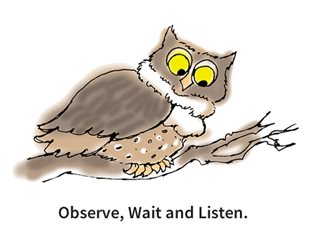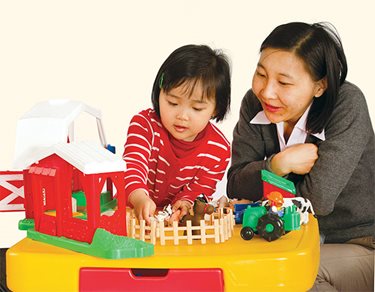The Waiting Game: An Essential Skill for Parents of Children with Language Delay
By Toby Stephan, Hanen Instructor, and Tamara Stein, Clinical Program Assistant
“You must be so patient!” is one of the most common responses I get when I tell people that I’m a pediatric speech-language pathologist. The truth is, I’m not. In my regular life I am the type of person who will abandon groceries in my cart if the line is too long. However, patience is not just a virtue, it’s a necessary skill for interacting with young children. When we want a child to initiate, or take a turn, we need to wait. Luckily, I had many opportunities during my clinical placements to hone this skill so by the time I graduated, my waiting skills looked natural. So, I can sympathize with parents who find it challenging to wait when interacting with their child. They need lots of help and guidance. In this article I discuss how I coach parents to wait.
Why Wait?
 The first step to getting parents on board with waiting is to explain why we wait. To get parents in the mindset of becoming an ideal communication partner for their child, I ask them who they like to talk with. What is it about this person that makes him or her easy to talk to? Usually, the parents will say “He ‘gets’ me” or “She’s a really good listener.” I’ll probe deeper, and ask “How do you know when someone’s listening to you?” Answers include, “He waits for me to finish talking”, “He doesn’t just offer me advice or tell me what to do”, or “He looks at me as if he’s interested.” Then I tell parents that these are the same strategies to use with their children .
The first step to getting parents on board with waiting is to explain why we wait. To get parents in the mindset of becoming an ideal communication partner for their child, I ask them who they like to talk with. What is it about this person that makes him or her easy to talk to? Usually, the parents will say “He ‘gets’ me” or “She’s a really good listener.” I’ll probe deeper, and ask “How do you know when someone’s listening to you?” Answers include, “He waits for me to finish talking”, “He doesn’t just offer me advice or tell me what to do”, or “He looks at me as if he’s interested.” Then I tell parents that these are the same strategies to use with their children .
Parents and caregivers benefit from being taught to use very practical strategies that let the child know he/she is an important part of the conversation. This is why the strategy of OWL or, Observe, Wait, and Listen is the first strategy that parents need to learn. When they use the OWL strategy effectively, the child gets the message that he’s being encouraged to initiate or start up the interaction. The parents certainly need to learn additional strategies to help their child, but the rest of the strategies build on this premise of increasing the child’s ability to initiate interaction. A child must be able to initiate to participate in conversations.
In fact, the more a child initiates, the more feedback and language input he receives from his caregivers on a topic of interest to him, making language learning a dynamic, child-driven process. This is why we say, “Children who lead get the language they need.” Children who seldom initiate receive less language input from their caregivers and it may not be on a topic of interest to the child. They may also miss out on those motivating, extended interactions about topics of great interest to them, which provide such rich language-learning opportunities.
What is OWL?
 OWLing is all about being a good conversation partner. While OWL stands for three separate skills (observing, waiting, and listening), a parent really needs to be doing all three at once.
OWLing is all about being a good conversation partner. While OWL stands for three separate skills (observing, waiting, and listening), a parent really needs to be doing all three at once.
The parent Observes the child carefully, paying close attention to what he says or does. Sometimes the child will initiate and this will be a clear and intentional effort to communicate through actions, gestures, sounds or words. Sometimes the child might simply start some activity or routine. This tells the parent what the child is interested in.
Waiting gives the child time to initiate or to show interest in something. This is difficult for most people because waiting means you are letting go of control of the interaction. I tell parents to keep silent and wait for 5-10 seconds, while face-to-face with their child. This gives the child time to initiate, or indicate their interests. It lets the child take charge of the interaction. Waiting lets the child know “I think you’re important, and I’m interested in what you have to say .”
Listening is essential. Rather than thinking about what to say next, the parent should be listening to their child so that they can respond appropriately to whatever the child says. By listening, and then responding on topic to what their child says, the parent is letting the child know that they are genuinely present and focused on the child. It makes the child feel powerful.
Emphasize Waiting
If the parent focuses on Waiting, then Observe and Listen tend to occur naturally.
When I teach the parents to OWL, I usually focus on the wait. Waiting gives the parent time to observe what the child might do or say. When the child says or does something, the parent responds, thereby showing the child that he or she is listening. If the parent focuses on waiting, then observe and listen tend to occur naturally.
As a therapist, you will have to help the parent decide how long to wait and what to wait for. First, the adult has to experiment to find out how much time the child needs in order to initiate. Some children who are language delayed have not developed a sense of themselves as initiators, and so, they may need the parent to wait longer – even 10 seconds – to send the message that the child is expected to initiate. With other children, who are very active and distractible, if the adult waits too long, the child may bolt. As in the Goldilocks fairy tale, the parent needs to discover the “just right” amount of time to wait. A good place to start with this experiment is by counting (silently) to 5 or 10. With practice, the parent will learn how much time their child needs.
The parent also needs to think about what he or she is waiting for. This will be different for each child, based on his or her stage of development. The parent will likely need your help to answer questions such as “What should we expect from our child right now if we wait?” or, “What might be the very next thing we could expect from our child, if we wait?” If parents don’t know what to expect, they may not respond to important non-verbal initiations.
Seeing Is Believing
To drive home the importance of waiting, I try to record a clip of the parents applying the strategy using either a tablet or cell-phone. It is difficult to be fully aware of how a strategy is working in the moment. However, if you have a clip, you can show it to the parent after they’ve tried waiting so they can see for themselves what it looks like and how it increases the number of times their child initiates.
Share Your Personal Experiences
As a beginning clinician, you have probably had to practice OWLing with a variety of children. We also know how different OWLing can be depending on the child’s style of communication and stage of language development. The things you have discovered in your own work are valuable stories that you can share with future parents and caregivers on your caseload.
Create a Home Plan with the Parent
At the end of a coaching session, the parent and I discuss how they will try OWLing at home. We talk about how it takes time to change behaviour and so it’s a good idea to choose one activity or time of day at first. This allows the parent to make behaviour changes in small steps. I’ll ask the parent “When do you have the most fun with your child?” Then I’ll suggest that they try OWLing in that activity – whether it’s play dough, bath time, dinner, or any other time of day. I’ll ask them what they think it would look like to OWL during that activity, when they would OWL, how long they would wait and what they expect their child to do. We then create a written plan in which they note all these points so they can use the plan to guide them as they apply OWL during an interaction. As we know, practice makes progress, so I ask the parent to try to use OWL at least 3-4 times a day during the chosen activity.
In Conclusion...
Learning to wait is one of the hardest but most essential skills that we can teach parents. OWL provides the foundation for a naturalistic approach to language learning that sets families up for communication success.
Share this fun activity sheet with parents to help them OWL with their child
The Hanen Centre is a Canadian not-for-profit charitable organization with a global reach. Its mission is to provide parents, caregivers, early childhood educators and speech-language pathologists with the knowledge and training they need to help young children develop the best possible language, social and literacy skills. This includes children who have or are at risk for language delays, those with developmental challenges such as autism, and those who are developing typically.